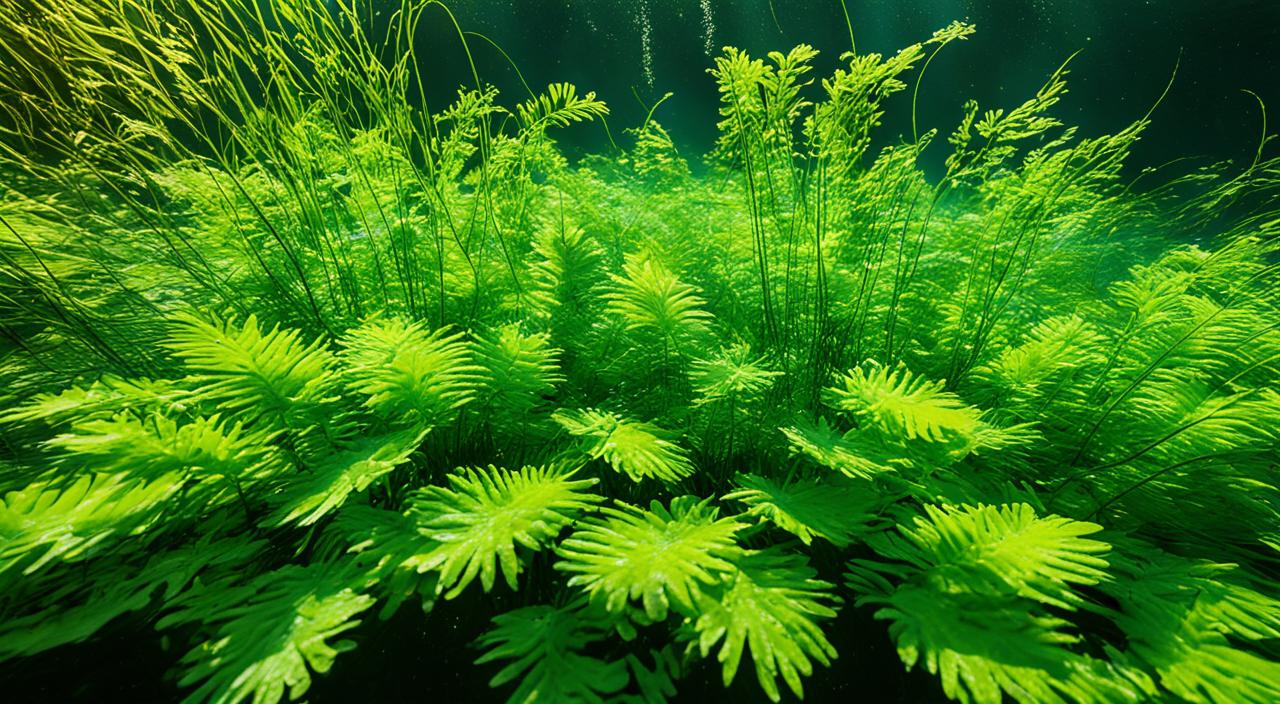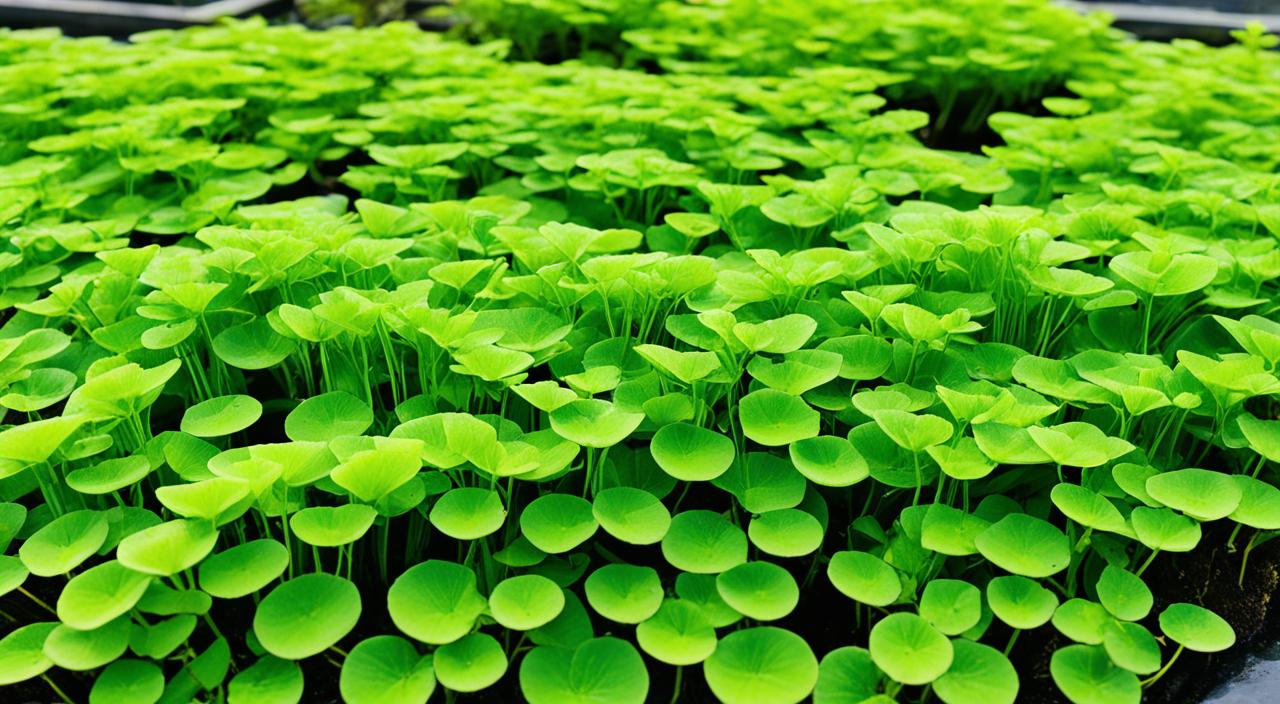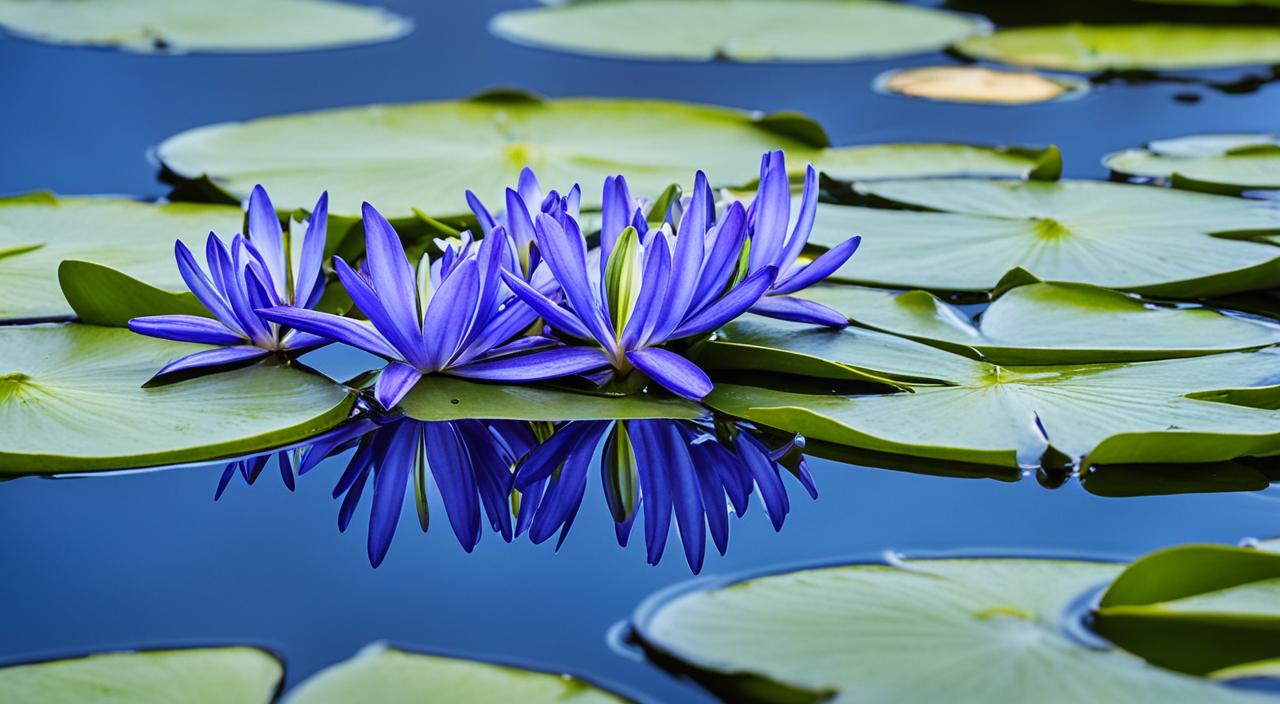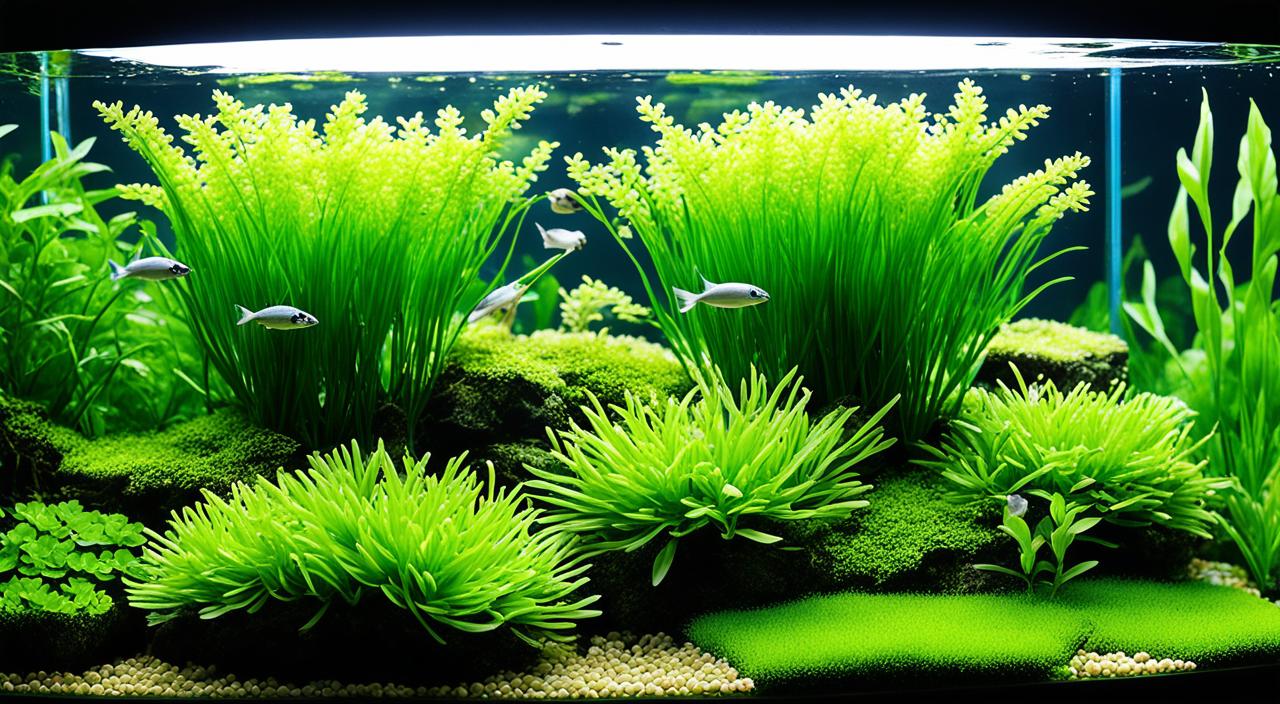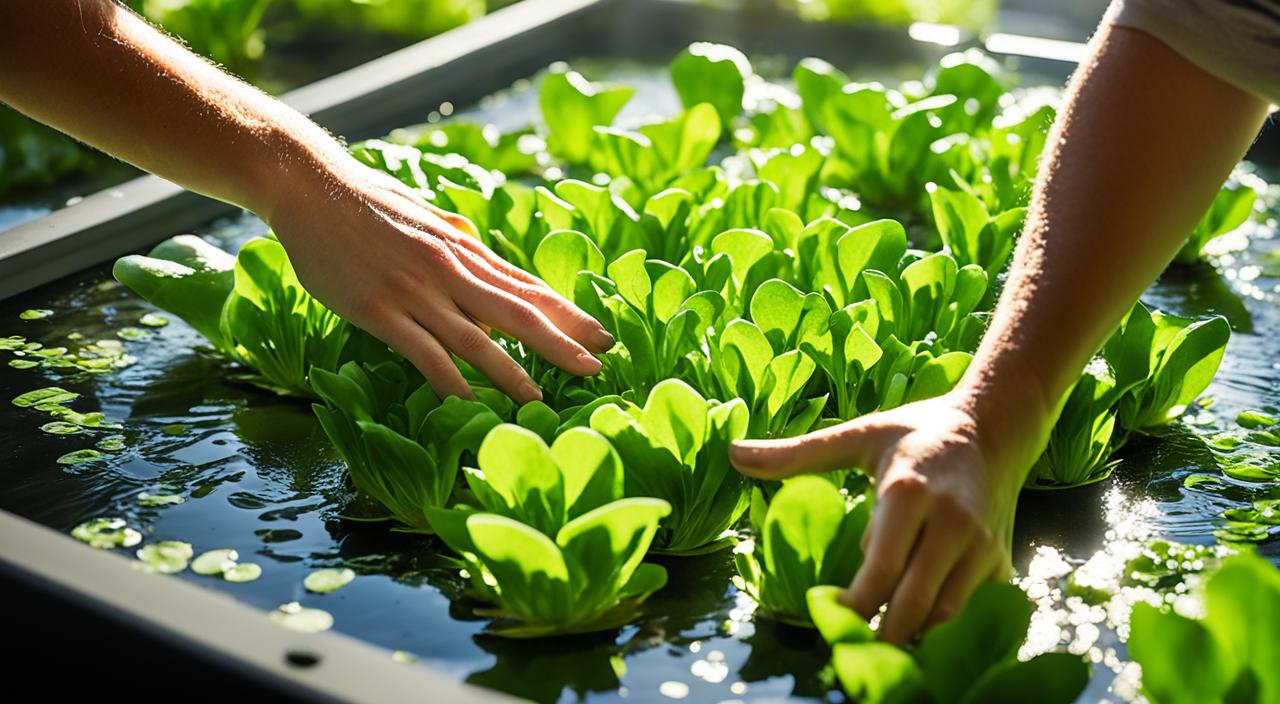Growing aquatic plants in your aquarium adds beauty and vibrancy to your underwater world and provides essential benefits for your fish’s overall health and well-being. If you’re looking for a versatile and visually stunning plant that can thrive in various conditions, look no further than Riccia fluitans, also known as Crystalwort. In this article, I will guide you through the care and maintenance of this popular and captivating floating aquarium plant.
Brief Overview Of Riccia fluitans (Crystalwort)
Riccia fluitans, or Crystalwort, is a versatile and popular aquatic plant often used by aquarists to create lush and visually appealing aquascapes. It has a mossy and vivid appearance can add depth and texture to any tank. Riccia fluitans can be grown as a floating plant or attached to rocks, driftwood, or other surfaces to create a carpet effect. It requires moderate to high lighting and benefits from adding CO2 to support its growth. The plant propagates easily and can be divided into smaller portions for propagation. It is a popular choice for carpeting plants in aquascaping due to its low maintenance requirements and ability to cover large areas quickly.
| Characteristic | Description |
|---|---|
| Scientific Name: | Riccia fluitans |
| Common Names: | Crystalwort, Floating Riccia |
| Origin: | Cosmopolitan |
| Height: | Forms a thick mat on the water surface or attached substrate; height varies based on trimming and growth |
| Growth Rate: | Fast |
| Colour: | Bright green |
| Aquarium Placement: | Floating or attached to rocks and driftwood with mesh or fishing line |
| Water Type: | Freshwater |
| pH: | 6.0 – 7.5 |
| Care Level: | Moderate |
| Light Requirements: | High (50-70 PAR) benefits from 6500K to 7000K light spectrum for optimal growth |
| CO2 Requirements: | High, CO2 supplementation significantly boosts growth and health |
| Temperature: | 15°C – 28°C (59°F – 82°F) |
| Flow Rate: | Low to moderate; strong currents may cause it to break apart if not anchored |
| Propagation: | Fragmentation – new clumps form from broken pieces or when trimmed |
| Feed Type: | Absorbs nutrients from water; benefits from liquid fertilizers if not enough nutrients are present |
In terms of light requirements, Riccia fluitans thrive under high light conditions. A PAR (Photosynthetically Active Radiation) value of 50-70 is generally recommended for robust growth. The ideal light spectrum is around 6500K to 7000K, closely mimicking natural daylight and effectively supporting photosynthesis. While Riccia can grow under various lighting conditions, providing the right intensity and spectrum can significantly enhance its colour, density, and overall health.
Origins And Habitat
Riccia fluitans, or Crystalwort, is a versatile aquatic plant originating in Asia, Africa, and the Americas. Due to its adaptability, it can now be found in various regions worldwide. In its natural habitat, it is commonly found floating in ponds and slow-moving streams. However, it can also thrive in aquariums, making it popular among aquarists.
The pH tolerance of Riccia fluitans is quite broad, ranging from 6.0 to 8.0. This makes it compatible with various water conditions, allowing it to adapt to different environments. In aquascaping, Riccia fluitans are often utilized to create stunning and natural-looking underwater landscapes. It can be attached to rocks, driftwood, or other surfaces to achieve carpeting effects. Alternatively, it can float freely, providing cover for fish and fry.
Morphological Characteristics
Riccia fluitans, also known as Crystalwort, is a small, green aquatic plant with a unique appearance. It consists of clumps of short, vivid green threads that can grow into a ball-like shape if not trimmed. Unlike traditional plants, Riccia fluitans do not have a proper root structure. Instead, it can anchor to other surfaces over time, making it a versatile and adaptable plant for various aquascaping techniques.
When cultivated as a carpet, Riccia fluitans form a dense and lush bed of green foliage, providing the aquarium with a vibrant and natural look. The interwoven threads of the plant create a visually appealing and textured carpet effect that enhances the overall aesthetic of the tank. In addition to carpeting, Riccia fluitans is often used as a floating plant. It creates mats of interconnected threads on the water’s surface, adding dimension and interest to the aquarium while providing shelter for fish and fry.
Placement And Lighting
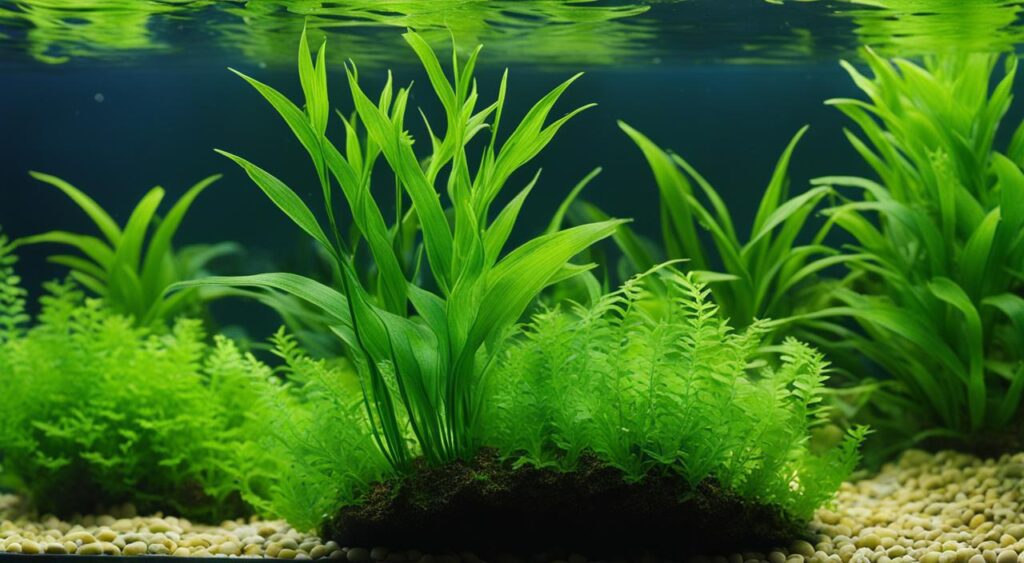
Riccia fluitans, also known as Crystalwort, is a versatile aquatic plant that thrives in tanks with medium to high lighting conditions. The amount of light it receives directly impacts its growth and overall health. Riccia fluitans can tolerate lower light levels when used as a floating plant. However, when attached to surfaces or grown as a carpet in the aquarium, it requires brighter lights to reach its full potential.
Adding carbon dioxide (CO2) can be beneficial in optimizing the growth of Riccia fluitans and promoting photosynthesis. CO2 supplementation supports the plant’s metabolism and enhances its ability to utilize light energy for growth.
When considering the placement of Riccia fluitans in the aquarium, it is crucial to ensure that it receives adequate lighting. This can be achieved by strategically positioning the plant in areas with the highest light intensity. Riccia fluitans can be attached to rocks, driftwood, or mesh to create a carpet effect, allowing it to receive direct lighting and grow densely. Alternatively, it can float freely on the water’s surface, providing a natural and visually appealing floating plant appearance.
What Are Good Tank Mates?
Riccia fluitans, or Crystalwort, can coexist harmoniously with various fish species and other aquatic animals. When selecting tank mates for Riccia fluitans, it is essential to consider species that will not nibble or uproot the delicate plant, as this can hinder its growth and overall health. Fortunately, several fish species and other aquatic animals can make suitable companions for Riccia fluitans in your aquarium.
Good Tank Mates
Some of the best tank mates for Riccia fluitans include small fish species that are peaceful and compatible with the plant. Here are a few examples:
- Guppies
- Tetras
- Rasboras
In addition to small fish, shrimp and snails can coexist well with Riccia fluitans. These aquatic inhabitants can contribute to a balanced ecosystem in your tank.
Fish Species To Avoid
While many fish species can peacefully coexist with Riccia fluitans, a few should be avoided due to their potential to damage the plant. Fish species that may nibble on or uproot the delicate threads of Riccia fluitans should not be considered tank mates. Examples of species to avoid include:
- Goldfish
- Large cichlids
You can ensure a beautiful and thriving environment for your Riccia fluitans and other aquatic inhabitants by selecting suitable tank mates.
Feeding (Fertilization)
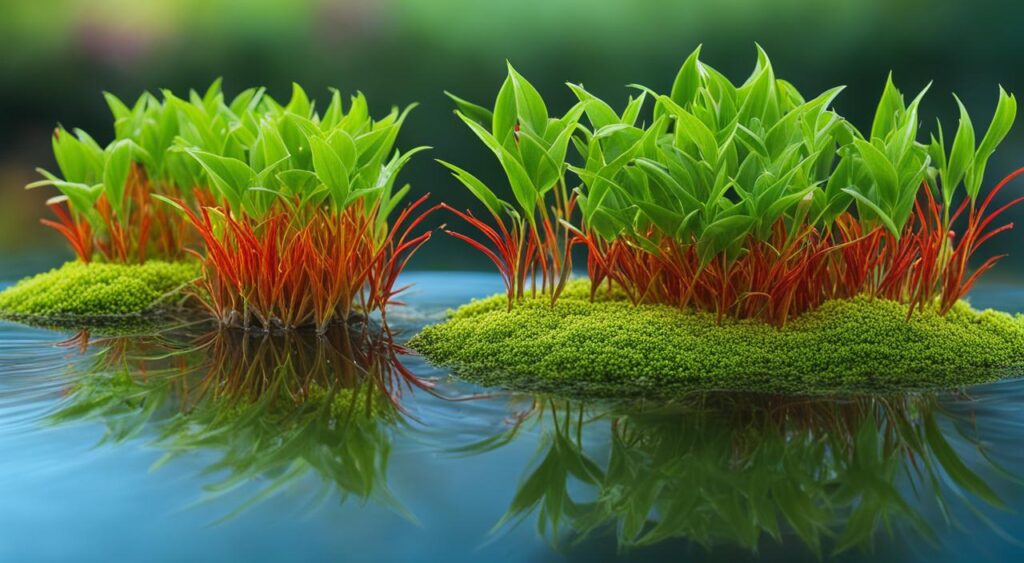
Riccia fluitans, also known as Crystalwort, is a low-maintenance aquatic plant that primarily absorbs nutrients through its leaves and stems rather than relying on a root system. While it does not require specific feeding, regular fertilization can benefit its growth and health.
When fertilizing Riccia fluitans, liquid fertilizers designed for aquatic plants are recommended. According to the manufacturer’s instructions, these fertilizers should be added to the water to provide moderate to high levels of essential nutrients, including nitrates, phosphates, iron, and potassium.
The frequency of fertilization can vary depending on your aquarium’s specific needs and the plant’s growth rate. It is essential to monitor the appearance and growth of Riccia fluitans to determine if adjustments to the feeding routine are necessary.
How Much And How Often To Feed
The amount and frequency of fertilization for Riccia fluitans can depend on several factors, including the size of your aquarium, the number of plants, and the overall nutrient levels in the water. It is generally recommended to start with the recommended dosage of the liquid fertilizer and then adjust as needed based on the plant’s response.
As a general guideline, fertilizing Riccia fluitans once or twice a week is recommended. However, the exact frequency may vary depending on your aquarium’s requirements and the plant’s growth rate.
Regularly monitoring the plant’s colour, growth, and overall health will help determine if you need to adjust the feeding schedule. If the plant appears pale, has slow growth, or shows signs of nutrient deficiencies, you may need to increase the fertilization frequency or adjust the dosage accordingly.
CO2 Injection
Riccia fluitans, or Crystalwort, can significantly benefit from adding carbon dioxide (CO2) to the aquarium water. CO2 supplementation enhances the photosynthetic process in plants, including Riccia fluitans, and promotes healthy growth. There are different methods of CO2 injection available, allowing aquarists to choose the most suitable option based on the size of their tank, the specific CO2 requirements of the plant, and personal preferences.
Types of CO2 Injection
Several types of CO2 injection methods can be used for Crystalwort:
- Compressed Gas Systems involve a pressurized CO2 cylinder and a regulator. The CO2 is released into the aquarium through a diffuser or atomizer, ensuring a controlled and consistent supply of CO2.
- CO2 Liquid Additives: Liquid CO2 additives can be added directly to the aquarium water. These additives contain dissolved CO2 that the plants can absorb. They provide a convenient and easy-to-use alternative to compressed gas systems.
- DIY Yeast-based CO2 Systems: DIY CO2 systems involve the fermentation of yeast and sugar to produce CO2. The CO2 is injected into the aquarium using a diffuser or similar device. DIY CO2 systems are cost-effective but require regular maintenance and monitoring.
When using any CO2 injection, monitoring the CO2 levels in the aquarium and adjusting the injection rate as needed is crucial. Fluctuations or imbalances in CO2 levels can negatively impact the health of the plants and other tank inhabitants. Maintaining stable and appropriate CO2 levels will contribute to the overall well-being and growth of Riccia fluitans in the aquarium.
Care
Proper care is essential for the health and thriving of Riccia fluitans, also known as Crystalwort. To ensure optimal growth, it is crucial to maintain suitable planted tank parameters, monitor water quality, and provide proper filtration and water flow.
Planted Tank Parameters
To create an ideal environment for Riccia fluitans, it is essential to maintain appropriate water temperature, pH, and hardness levels within the recommended range. The plant thrives best in water temperatures between 59°F to 86°F and a pH range of 6.0 to 8.0. It is essential to regularly test and monitor these parameters to ensure they remain stable and balanced.
Water Quality
Water quality plays a vital role in the growth and overall health of Riccia fluitans. Regular testing is necessary to ensure the water remains free from harmful substances and maintains the proper nutrient balance for the plant. Using liquid fertilizers designed for aquatic plants to provide nutrients like nitrates, phosphates, iron, and potassium is recommended. By maintaining optimal water quality, you can promote the vibrant growth and lush appearance of Riccia fluitans.
Filtration
Proper filtration is essential in preventing the accumulation of debris and maintaining water clarity. A sound filtration system will help remove excess waste, chemicals, and toxins to keep the water clean and healthy for Riccia fluitans. Consider using a filter appropriate for your aquarium size, and clean or replace the filter media regularly to ensure its effectiveness.
Flow
Providing moderate water movement is crucial for Riccia fluitans. The gentle flow helps to distribute nutrients evenly and prevents stagnant conditions that can lead to the accumulation of debris and algae growth. Consider using a powerhead or an appropriately sized aquarium pump to create gentle water movement in the tank. By maintaining proper flow, you can ensure the health and vitality of Riccia fluitans in your aquarium.
Aquarium Maintenance
Regular aquarium maintenance is crucial for the health and growth of Riccia fluitans. Following a few essential practices ensures that your aquarium remains clean and the plant thrives.
Testing Water Conditions
Regularly testing the water conditions in your aquarium is essential to maintain optimal parameters for Riccia fluitans. A reliable water testing kit monitors pH, ammonia, nitrite, and nitrate levels. Adjustments can then be made to ensure these levels remain within the appropriate range for the plant’s health and growth.
How To Set Up Your Aquarium Tank
Properly setting up your aquarium tank is vital to creating a suitable environment for Riccia fluitans. Here are some key considerations:
- Lighting: Provide adequate lighting for the plant’s growth. High-intensity LED lights or fluorescent lights are recommended.
- CO2 Supplementation: Consider adding CO2 to the aquarium water to enhance the growth of Riccia fluitans. CO2 injection systems or liquid CO2 additives can be used.
- Tank Mates: Choose suitable tank mates that do not uproot or damage the plant. Small fish, shrimp, and snails can be compatible companions.
Propagation Methods
Propagating Riccia fluitans is relatively straightforward and can be done through division. Here’s how:
- Carefully divide the plant into smaller portions.
- Attach these portions to rocks, driftwood, or mesh using a fishing line or thin thread.
- Allow the new growth to hold the plant down over time.
Regularly trimming the plant will prevent overgrowth and help maintain its desired shape and appearance.
Health And Disease
Monitoring the health of Riccia fluitans is essential for its long-term survival and growth. By observing specific indicators, you can determine the overall well-being of this aquatic plant. Signs of good health in Riccia fluitans include vibrant green colouration, indicating proper chlorophyll production, new growth and a dense and compact appearance. These characteristics suggest that the plant receives adequate nutrients and thrives in its environment.
On the other hand, signs of poor health in Riccia fluitans may include browning or yellowing of the plant, indicating nutrient deficiencies or improper lighting conditions. Slow or stunted growth and thinning or sparse foliage are additional indications that the plant is not in optimal health. These signs may also suggest underlying health issues that need to be addressed.
Common Health Issues And Treatment
Some common health issues affecting Riccia fluitans include nutrient deficiencies, algae growth, and pests. Nutrient deficiencies can be addressed by providing appropriate fertilization. Following the manufacturer’s instructions, this can be done using liquid fertilizers formulated explicitly for aquatic plants. It is vital to provide moderate to high levels of nutrients, including nitrates, phosphates, iron, and potassium, to support the plant’s growth and overall health.
Algae growth can be controlled by maintaining proper water parameters, such as lighting intensity and duration, carbon dioxide levels, and nutrient balance. Implementing a regular maintenance routine, including trimming and removing excess algae manually, can help keep the plant healthy and prevent further infestation.
Plant Pests
Riccia fluitans can be susceptible to pests such as snails and algae-eating fish. These pests can damage the plant by nibbling on its delicate threads or consuming its tissues. Removing plant pests manually from the tank or introducing natural predators that can help control their population is essential to deal with plant pests. Maintaining a clean and well-maintained aquarium can minimize the risk of pest infestation.
Regular monitoring, timely intervention, and proper care can help ensure the health and vitality of Riccia fluitans. You can create a thriving and visually appealing aquarium with this beautiful aquatic plant by addressing any health issues promptly and taking proactive measures to prevent pests and nutrient imbalances.
Summary
In conclusion, Riccia fluitans, or Crystalwort, is a versatile and visually appealing aquatic plant that can significantly enhance the aesthetics of any aquarium. Whether used as a floating plant or as a carpeting plant, Riccia fluitans add a lush and natural touch to the underwater environment. This plant is relatively easy to care for, making it suitable for both beginner and experienced aquarists.
For optimal growth, Riccia fluitans requires moderate to high lighting conditions. Consider adding CO2 supplementation to promote healthy growth and vibrant green foliage. With the proper lighting and CO2 levels, Riccia fluitans can create a stunning aquascape.
One of the advantages of Riccia fluitans is its compatibility with various fish species and other aquatic animals. It can peacefully coexist with small fish, shrimp, and snails. However, avoiding incompatible fish species that may damage or uproot the plant is vital.
To keep Riccia fluitans healthy, regular water quality monitoring, proper filtration, and maintenance routines are essential. This includes maintaining stable water parameters, testing for nutrient deficiencies, controlling algae growth, and dealing with potential plant pests. By following these guidelines, you can enjoy the vibrant and natural look that Riccia Fluitans bring to your aquarium.
FAQ
How easy is it to care for Riccia fluitans (Crystalwort)?
Riccia fluitans is relatively easy to care for and is a popular choice among aquarists. It requires moderate to high lighting and benefits from the addition of CO2 for optimal growth.
What are the origins and habitat of Riccia fluitans?
Riccia fluitans is native to Asia, Africa, and the Americas and can be found floating in ponds and slow-moving streams. It is commonly used in aquascaping to create visually appealing underwater landscapes.
What are the morphological characteristics of Riccia fluitans?
Riccia fluitans consists of clumps of short, vivid green threads that can form a moss-like appearance. It can be grown as a carpet or as a floating plant.
Where should I place Riccia fluitans in the aquarium and what lighting does it require?
Riccia fluitans can be attached to rocks, driftwood, or mesh to create a carpet effect or allowed to float freely. It requires moderate to high lighting conditions for optimal growth.
What are good tank mates for Riccia fluitans (Crystalwort)?
Good tank mates for Riccia fluitans include small fish like guppies, tetras, and rasboras. Shrimp, snails, and bottom-dwelling fish like corydoras catfish can also be suitable tank mates.
What should I feed Riccia fluitans?
Riccia fluitans primarily absorbs nutrients through its leaves and stems but can benefit from regular fertilization. Liquid fertilizers designed for aquatic plants can be added to the water according to the manufacturer’s instructions.
Should I inject CO2 into the aquarium for Riccia fluitans?
Riccia fluitans can benefit from the addition of CO2 to support its growth. There are different methods of CO2 injection available, including compressed gas systems, CO2 liquid additives, and DIY yeast-based CO2 systems.
What are the care requirements for Riccia fluitans?
To care for Riccia fluitans effectively, it is important to maintain suitable planted tank parameters, including appropriate water temperature, pH, hardness levels, and stable water quality. Regular aquarium maintenance, trimming, and proper water flow are also crucial.
How do I propagate Riccia fluitans?
Riccia fluitans can be propagated by dividing the plant into smaller portions and attaching them to rocks, driftwood, or mesh. Regular trimming is also necessary to prevent overgrowth.
What are the signs of good health and common health issues for Riccia fluitans?
Signs of good health for Riccia fluitans include vibrant green coloration, new growth, and a dense and compact appearance. Common health issues may include nutrient deficiencies, algae growth, and plant pests like snails or algae-eating fish.
Can you summarize the care and characteristics of Riccia fluitans?
Riccia fluitans is a versatile and visually appealing aquatic plant that can be used as a floating or carpeting plant. It requires moderate to high lighting and can benefit from CO2 supplementation. Good tank mates include small fish and invertebrates. Regular maintenance, proper water quality, and suitable propagation methods are essential for its care.

